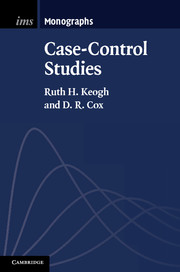Crossref Citations
This Book has been
cited by the following publications. This list is generated based on data provided by Crossref.
Yee, Thomas W.
2015.
Vector Generalized Linear and Additive Models.
p.
127.
Yee, Thomas W.
2015.
Vector Generalized Linear and Additive Models.
p.
3.
Borgan, Ørnulf
and
Keogh, Ruth
2015.
Nested case–control studies: should one break the matching?.
Lifetime Data Analysis,
Vol. 21,
Issue. 4,
p.
517.
Cox, David R.
2016.
The design of empirical studies: towards a unified view.
European Journal of Epidemiology,
Vol. 31,
Issue. 3,
p.
217.
Spivack, John H.
and
Cheng, Bin
2016.
Estimating odds ratios under a case-background design with an application to a study of Sorafenib accessibility.
The Annals of Applied Statistics,
Vol. 10,
Issue. 4,
Keogh, Ruth H.
Mangtani, Punam
Rodrigues, Laura
and
Nguipdop Djomo, Patrick
2016.
Estimating time-varying exposure-outcome associations using case-control data: logistic and case-cohort analyses.
BMC Medical Research Methodology,
Vol. 16,
Issue. 1,
ROSENFELD, BRYN
2017.
Reevaluating the Middle-Class Protest Paradigm: A Case-Control Study of Democratic Protest Coalitions in Russia.
American Political Science Review,
Vol. 111,
Issue. 4,
p.
637.
Verani, Jennifer R.
Baqui, Abdullah H.
Broome, Claire V.
Cherian, Thomas
Cohen, Cheryl
Farrar, Jennifer L.
Feikin, Daniel R.
Groome, Michelle J.
Hajjeh, Rana A.
Johnson, Hope L.
Madhi, Shabir A.
Mulholland, Kim
O'Brien, Katherine L.
Parashar, Umesh D.
Patel, Manish M.
Rodrigues, Laura C.
Santosham, Mathuram
Scott, J. Anthony
Smith, Peter G.
Sommerfelt, Halvor
Tate, Jacqueline E.
Victor, J. Chris
Whitney, Cynthia G.
Zaidi, Anita K.
and
Zell, Elizabeth R.
2017.
Case-control vaccine effectiveness studies: Preparation, design, and enrollment of cases and controls.
Vaccine,
Vol. 35,
Issue. 25,
p.
3295.
Gaylor, Luke
Junge, Mirko
and
Abanteriba, Sylvester
2017.
Efficacy of seat-mounted thoracic side airbags in the German vehicle fleet.
Traffic Injury Prevention,
Vol. 18,
Issue. 8,
p.
852.
Battisti, Michele
Lavezzi, Andrea Mario
Masserini, Lucio
and
Pratesi, Monica
2018.
Resisting the extortion racket: an empirical analysis.
European Journal of Law and Economics,
Vol. 46,
Issue. 1,
p.
1.
Foschi, Francesco Giuseppe
Bedogni, Giorgio
Domenicali, Marco
Giacomoni, Pierluigi
Dall’Aglio, Anna Chiara
Dazzani, Francesca
Lanzi, Arianna
Conti, Fabio
Savini, Sara
Saini, Gaia
Bernardi, Mauro
Andreone, Pietro
Gastaldelli, Amalia
Casadei Gardini, Andrea
Tiribelli, Claudio
Bellentani, Stefano
and
Stefanini, Giuseppe Francesco
2018.
Prevalence of and risk factors for fatty liver in the general population of Northern Italy: the Bagnacavallo Study.
BMC Gastroenterology,
Vol. 18,
Issue. 1,
Urpilainen, E
Marttila, M
Hautakoski, A
Arffman, M
Sund, R
Ilanne‐Parikka, P
Arima, R
Kangaskokko, J
Puistola, U
Läärä, E
and
Hinkula, M
2018.
The role of metformin and statins in the incidence of epithelial ovarian cancer in type 2 diabetes: a cohort and nested case–control study.
BJOG: An International Journal of Obstetrics & Gynaecology,
Vol. 125,
Issue. 8,
p.
1001.
McKeague, Ian W.
and
Qian, Min
2019.
Marginal Screening of 2 × 2 Tables in Large-Scale Case-Control Studies.
Biometrics,
Vol. 75,
Issue. 1,
p.
163.
Hosio, Mayu
Urpilainen, Elina
Marttila, Mikko
Hautakoski, Ari
Arffman, Martti
Sund, Reijo
Puistola, Ulla
Läärä, Esa
Jukkola, Arja
and
Karihtala, Peeter
2019.
Association of antidiabetic medication and statins with breast cancer incidence in women with type 2 diabetes.
Breast Cancer Research and Treatment,
Vol. 175,
Issue. 3,
p.
741.
Helbich, Marco
2019.
Dynamic UrbanEnvironmentalExposures onDepression andSuicide (NEEDS) in the Netherlands: a protocol for a cross-sectional smartphone tracking study and a longitudinal population register study.
BMJ Open,
Vol. 9,
Issue. 8,
p.
e030075.
Suesse, Thomas
and
Liu, Ivy
2019.
Mantel–Haenszel estimators of a common odds ratio for multiple response data.
Statistical Methods & Applications,
Vol. 28,
Issue. 1,
p.
57.
Liebst, Lasse Suonperä
Philpot, Richard
Bernasco, Wim
Dausel, Kasper Lykke
Ejbye‐Ernst, Peter
Nicolaisen, Mathias Holst
and
Lindegaard, Marie Rosenkrantz
2019.
Social relations and presence of others predict bystander intervention: Evidence from violent incidents captured on CCTV.
Aggressive Behavior,
Vol. 45,
Issue. 6,
p.
598.
Lin, Yu-Chung
Brooks, Jennifer D.
Bull, Shelley B.
Gagnon, France
Greenwood, Celia M. T.
Hung, Rayjean J.
Lawless, Jerald
Paterson, Andrew D.
Sun, Lei
and
Strug, Lisa J.
2020.
Statistical power in COVID-19 case-control host genomic study design.
Genome Medicine,
Vol. 12,
Issue. 1,
Feifel, Jan
Gebauer, Madlen
Schumacher, Martin
and
Beyersmann, Jan
2020.
Nested exposure case-control sampling: a sampling scheme to analyze rare time-dependent exposures.
Lifetime Data Analysis,
Vol. 26,
Issue. 1,
p.
21.
Jay, Jonathan
2020.
Alcohol outlets and firearm violence: a place-based case–control study using satellite imagery and machine learning.
Injury Prevention,
Vol. 26,
Issue. 1,
p.
61.



